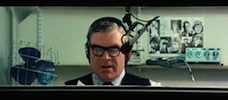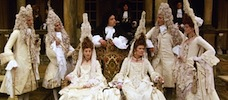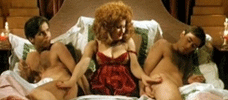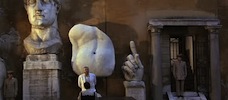Reviews
Reviews Peter Greenaway, Sacha Vierny, Michael Nyman, Ben van Os and Jan Roelfs

The Draughtsman’s Contract
Peter Greenaway
UK, 1982
Credits
Review by David Carter
Posted on 12 January 2010
Source Zeitgeist Video DVD
Categories Peter Greenaway, Sacha Vierny, Michael Nyman, Ben van Os and Jan Roelfs
While The Draughtsman’s Contract was Peter Greenaway’s first truly narrative feature, a follow-up to his mockumentary catalog film The Falls, the filmmaker himself refers to the film in its DVD liner notes as “another catalogue movie.” His assessment of his own work is, of course, correct but in a way that may not be immediately evident to the viewer. The Draughtsman’s Contract abandons the formal conventions of the documentary format of The Falls for a different type of formalism, that of the English period drama. The rigid structure of society depicted in the film and perhaps the even more fixed structure of art depicting that society are Greenaway’s setting for a ribald and humorous tale of sex, murder, and art.
Before the completion of the opening credits we see that Greenaway is not going to be bound by the formalist structure but is going to use it to satirize the genre and the society it reveres. In a typical scene of aristocrats at a party making conversation, we hear things like, “I used to piss like a horse. I still do.” This, coming from a woman bedecked in an elaborate period gown, is one of the first shots across the bow of English formality in the film, the first of many.
The film centers on Mr. Neville, an artist. As the son of a commoner, Neville is an outsider in the world of the aristocrats for whom he works. The film reiterates this visually; Neville dresses primarily in all black and wears a dark colored wig, a sharp contrast to the affected garb of the other characters. His outsider status also positions him as an avatar for the audience as he moves in what is essentially an alien world. But Neville’s position as the audience’s stand in is a precarious one. Greenaway purposefully makes him a difficult person to empathize with; he is arrogant, stubborn and malicious. Though Neville is quick to recognize these characteristics in his benefactors, he seems blind to the same within himself and his inability to “see” himself reiterates the blindness he has to the true nature of the events transpiring around him. Neville uses his art to capture this world visually but as the film progresses his understanding of the true world beneath the veneer grows. The Draughtsman’s Contract explores this with him, pulling back the curtain on a society obsessed with outward appearances.
The titular contract refers to Neville’s agreement with Mrs. Herbert to make twelve drawings of her husband’s estate, an offer that he initially declines. Neville is only persuaded to take on the project when he is able to write the contract in a more interesting manner. Mrs. Herbert agrees to perform twelve sexual favors for him, one for each drawing. Neville begins work confident that he has negotiated a singularly beneficial arrangement, one that puts him as the de facto lord of the manor while Mr. Herbert is away. As he begins to notice strange details in his paintings - a ladder here, a torn shirt there - Neville realizes that he is more pawn than king in the elaborate game of Mrs. Herbert and her daughter. The details point to murder and in solving the mystery, Neville may bring about his own.
Neville discovers that there is something more going on in the Herbert estate than he can depict visually and, indeed, there is something more going on in The Draughtsman’s Contract than there initially appears. If The Draughtsman’s Contract is, like The Falls, a catalogue film, it is one of a different type. Greenaway is expanding upon his short film The Falls as an exploration of the English countryside. Neville revisits the same areas for varying lengths of time in a manner similar to Greenaway’s in the short. What the artist finds is what the viewer finds in both works, that time and context change the perception of an image. One views Herbert’s estate in vastly different terms as the film progresses despite the fact the images themselves do not change. Neville’s contract stipulates that the subjects of his paintings must not be changed yet he sees this turned around on him in much the same way as the balance of power in his relationship with Mrs. Herbert.
The plot, at times, is simply there to facilitate the depictions of landscapes. Greenaway is working more as a painter than a filmmaker here, showing the opulence and beauty of the natural world as a direct contrast to the faux-opulence and ugliness of the English aristocratic society. Again echoes of The Falls appear, as one could easily understand the film as more of a sequence of still images rather than a traditional film. The scenery overwhelms the characters by design and Greenaway has created a living painting where the stiff, calculated movement of the manners-conscious aristocrats makes them little more than details in his tableau.
Narratively, Neville’s curiosity proves to be his undoing. On another level, it is his attempt to capture natural, living beauty that leads to his downfall; a slight allusion to his next film, A Zed & Two Naughts. A puzzle in both plot and structure, The Draughtsman’s Contract is an enticing and glorious beginning to Greenaway’s narrative films. Though he shows contempt for the formalism of the period drama, he shows himself to be a master of it as well. Here we see the beginnings of Greenaway’s attempts to meld narrative cinema and visual art, a defining characteristic of his work. The Draughtsman’s Contract is both intriguing and beautiful and represents another step in the journey from shorts like H is for House to films like The Cook, the Thief, His Wife & Her Lover and his more recent Rembrandt films.
More Peter Greenaway, Sacha Vierny, Michael Nyman, Ben van Os and Jan Roelfs
-

The Falls
1980 -

The Draughtsman’s Contract
1982 -

A Zed & Two Noughts
1985 -

The Belly of an Architect
1987 -

Drowning by Numbers
1988 -

The Cook, the Thief, His Wife & Her Lover
1989 -

Prospero’s Books
1991 -

The Baby of Mâcon
1993
We don’t do comments anymore, but you may contact us here or find us on Twitter or Facebook.


